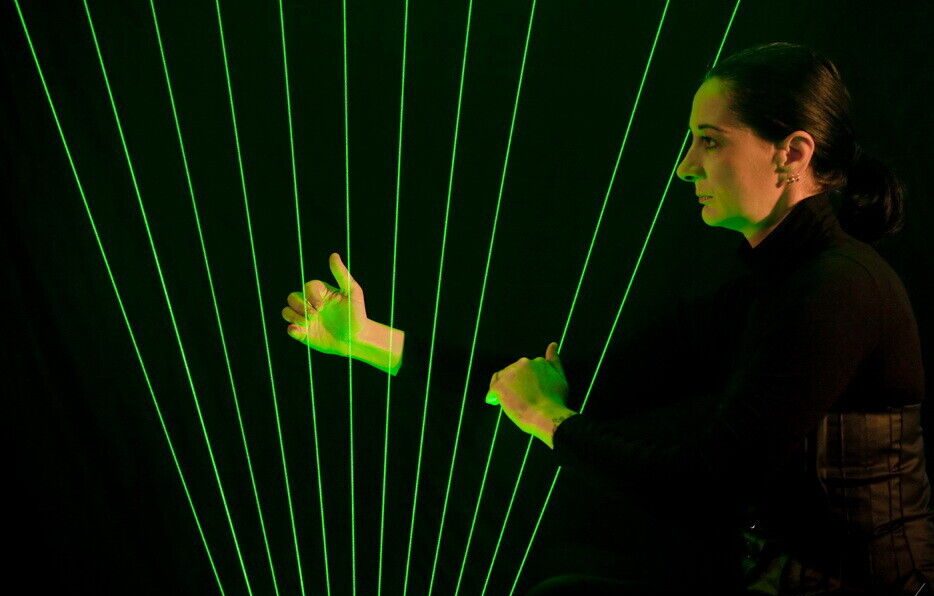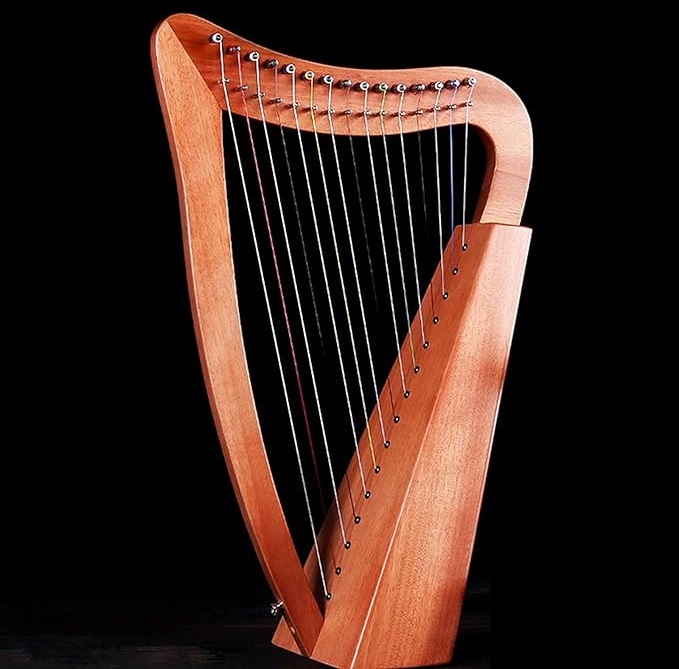Laser harp
Electronic Instruments
Europe
Between 1901 and present
Video
The Laser Harp is a modern electronic musical instrument that uses laser beams to produce sound. Unlike traditional instruments that rely on physical strings or air columns, the Laser Harp utilizes light to trigger sound. This innovative approach has made the Laser Harp a unique and visually captivating instrument, often associated with futuristic music performances, installations, and electronic music compositions.
Description
The Laser Harp operates by emitting beams of light, typically infrared, which are broken or interrupted when a performer’s hand or body comes into contact with the beams. The interruption of the beam sends a signal to a computer or synthesizer, which generates the corresponding sound. This system eliminates the need for physical contact with strings or pads, making it an entirely electronic instrument. The visual aspect of the Laser Harp, with its glowing beams and the interaction of the performer’s hands, adds an element of performance art to the music.
Laser Harps come in a variety of configurations, but the most common type consists of a series of laser beams projected horizontally across a frame, where each beam represents a different note or sound. Performers “pluck” or “break” the beams with their hands or fingers, similar to the action of plucking strings on a traditional harp or other stringed instrument.
Types of Laser Harp
Laser Harps can be categorized into different types based on their design, the technology used, and their intended use. Two primary types of Laser Harps are:
Traditional Laser Harp
The traditional Laser Harp is a free-standing frame with several laser beams, each corresponding to a different note. These beams are arranged horizontally or sometimes in a vertical configuration. This type of instrument typically uses infrared lasers, and the beams are often set at various heights, allowing the performer to control multiple notes by “striking” the beams.
MIDI Laser Harp
A MIDI Laser Harp is an advanced version that integrates with MIDI (Musical Instrument Digital Interface) technology. MIDI Laser Harps are used in electronic music studios and live performances to control synthesizers and other MIDI-compatible equipment. These harps often come with more complex software that allows for customizable sound manipulation and a broader range of musical expression.
History
The invention of the Laser Harp is attributed to French artist and inventor, Bernard Szajner, in the late 1970s. Szajner, who was involved in the world of electronic music and visual art, introduced the concept of the Laser Harp as part of his desire to explore the intersection of music, technology, and visual art. Szajner’s creation was unveiled at the 1979 “Expo 79” in Canada, and it soon gained attention for its futuristic look and innovative sound production.
Although the concept of using lasers for musical purposes had been explored in various forms, Szajner’s Laser Harp was the first to gain significant attention. Since then, the Laser Harp has evolved, with musicians, engineers, and inventors across the globe continuing to experiment with its design and potential.
The development of the Laser Harp is closely tied to advancements in electronic and digital music technology. The late 20th and early 21st centuries saw rapid advancements in synthesizers, MIDI systems, and digital audio processing, all of which contributed to the evolution of the Laser Harp.
Construction
The construction of a Laser Harp is relatively simple compared to traditional instruments. However, the technology required to make it functional is complex. At its core, a Laser Harp consists of a frame, laser emitters, optical sensors, and a computer or synthesizer for sound generation.
The frame of the Laser Harp is typically made from lightweight materials such as aluminum or plastic. It is designed to hold several laser emitters, which are usually arranged in a row or matrix pattern. The lasers emit infrared beams, which are invisible to the naked eye but can be detected by photodiodes or similar sensors. When a beam is interrupted, the sensor sends a signal to a connected sound system.
Laser Harps often come with adjustable settings that allow the user to modify the pitch and other aspects of the sound produced. The light beams themselves are typically red, blue, or green, but the color is not important for the functionality of the instrument. The sensors are usually positioned at the end of each beam to detect interruptions.
Laser Emitters
The laser emitters are the most important part of the construction. They are responsible for generating the beams that the performer interacts with. Lasers are typically low-powered infrared diodes that are safe for human exposure. These lasers are finely tuned to ensure accuracy in triggering sound generation.
Sensors
The sensors are placed across the laser beams to detect when a beam is interrupted. These sensors are typically photodiodes, which are sensitive to light and respond when the laser beam is broken. These interruptions are processed into signals that trigger the corresponding sound or note in the connected synthesizer or sound system.
Features
Laser Harps are known for their distinctive features, both in terms of their construction and their performance capabilities. Some of the key features include:
- Visual Appeal: The interaction with lasers creates a visually stunning performance, with the performer’s hands or body moving through glowing beams of light.
- Customization: Many Laser Harps allow for the customization of the sound, pitch, and effects, making them highly versatile for different genres of music.
- No Physical Contact: Unlike traditional stringed instruments, the Laser Harp does not require physical contact with strings or pads, making it a unique electronic instrument.
- MIDI Integration: Many modern Laser Harps are compatible with MIDI, which allows musicians to control other electronic instruments and software.
- Portability: While larger versions exist, many Laser Harps are designed to be portable, which makes them ideal for live performances and touring.
Sound Production
Sound production in a Laser Harp is completely digital, with no strings or resonating chambers involved. The laser beams themselves do not produce sound; rather, they serve as triggers for sound generation.
When a performer breaks or interrupts a laser beam, a sensor detects the interruption and sends a signal to a synthesizer or computer system. The sound generated is determined by the settings in the software or synthesizer, which can produce anything from traditional instrument sounds to futuristic electronic noises.
In more advanced systems, the sound can be manipulated in real-time, allowing for intricate modulation of pitch, tone, and effects. This flexibility is one of the key attractions of the Laser Harp, particularly for electronic musicians who value the ability to create unique sounds and performances.
Playing Methods
Playing the Laser Harp requires a performer to use their hands, fingers, or other parts of their body to break or interrupt the laser beams. This interaction mimics the action of plucking a string or pressing a key in traditional instruments.
The performer’s hand position relative to the laser beams can determine which note or sound is triggered. Since there is no physical contact with the instrument itself, the performer can stand or move freely in front of the Laser Harp, which allows for a wide range of performance styles. The physical act of breaking the beams can also produce a visually dynamic performance, which enhances the audience’s experience.
While the basic playing method is simple—interrupting a beam—the complexity arises from the performer’s ability to control multiple beams at once, often creating layered and intricate compositions.
Roles in Music and Significance
The Laser Harp plays a unique role in modern music, especially within the genres of electronic music, experimental music, and performance art. Its ability to generate sound through light allows for performances that are both auditory and visual, which makes it a powerful tool for multimedia performances.
One of the most significant aspects of the Laser Harp is its ability to expand the boundaries of music performance. Since the sound production is not reliant on traditional techniques like bowing or plucking, musicians are free to experiment with new ways of creating music. This has made the Laser Harp a favorite among electronic musicians and composers looking to push the limits of sound.
In live performances, the Laser Harp is often used as a spectacle, drawing attention not only for its sound but also for its visual effects. The sight of a musician interacting with beams of light creates an atmosphere of innovation and futuristic appeal.
Additionally, the Laser Harp has found use in film scores, especially in science fiction and fantasy genres, where the futuristic nature of the instrument fits the tone of the visual media. It is also used in sound installations, where the interactive nature of the instrument invites audience participation.
Significance in Modern Music
The Laser Harp represents the fusion of technology and music. It reflects the growing trend of integrating digital tools and instruments into musical compositions, allowing for the creation of new sounds that were not possible with traditional instruments. Its significance lies in its ability to bring together the realms of technology, visual art, and music, which has resonated with musicians and audiences alike. The Laser Harp is not just an instrument; it is an embodiment of the future of music-making.
The Laser Harp is a revolutionary instrument that blends technology with traditional musical elements. Its ability to produce sound without physical contact, coupled with its mesmerizing visual appeal, has made it an essential tool in the world of electronic music and performance art. Its history, construction, and unique features offer insight into how music continues to evolve, embracing new technologies to expand creative possibilities. As a symbol of the future of music, the Laser Harp is poised to remain an influential instrument in both live performances and studio settings.
FAQ
What materials are used to construct a Laser Harp?
Laser Harps are typically constructed using lightweight materials such as acrylic for frames, along with electronic components like lasers, sensors, and microcontrollers. These materials ensure durability while allowing for portability.
How is a Laser Harp constructed?
A Laser Harp consists of three main components: laser projectors that emit light beams, sensors that detect interruptions in these beams, and a controller that processes signals into MIDI notes for sound output.
What is involved in building a Laser Harp?
Building a Laser Harp involves careful arrangement of lasers and sensors along with programming a controller to interpret beam interruptions as musical notes, requiring both technical knowledge and creativity.
 Links
Links
References
Other Instrument
Categories



















